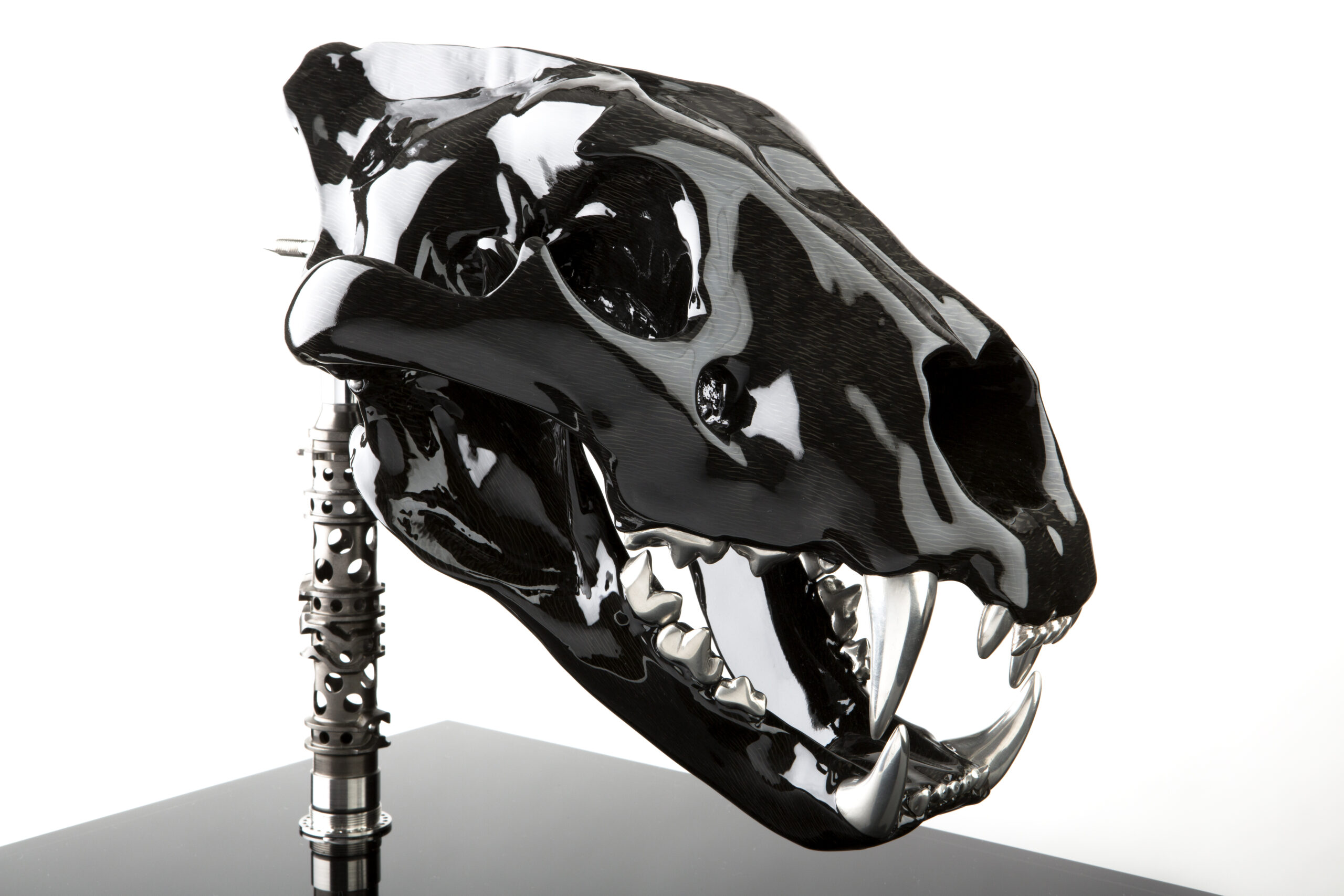Alastair Gibson, a renowned artist known for his exceptional sculptures in carbon fibre, is pushing the boundaries of his chosen medium to create artworks that challenge its capabilities and explore broader themes of development and potential.
When one contemplates a lion’s skull, it is hard not to be captivated by its teeth. The mere mention of the word prompts us to reflect on our own mouths. The explosive consonants make us press our tongues against our incisors and canines, while the elongated ‘ee’ sound stretches our lips wide, creating a moment of anticipation, whether it be a smile or a bite.
Observing the roar or yawn of a lion from a distance, be it in the wild, behind the confines of a zoo enclosure, or abstractly through a digital screen, allows us to safely ponder the lethal capabilities of Africa’s dominant predator. However, it is the configuration of the entire jaw, not just its cutting tools, that truly embodies the immense power of the king of beasts, as it dispatches its prey by breaking their necks or suffocating them.
Capturing the layered potency of the apex predator, Alastair Gibson has created Carbon King, a limited-edition sculpture of a lion’s head in solid carbon fibre, anatomically correct and to scale. The pioneering artist has used a bismuth alloy for the teeth, a hard yet brittle material, while the bone structure of the skull consists of 333 layers of carbon fibre, emphasizing the brutal tenacity of a lion’s hunting technique.
In contrast to Damien Hirst’s “The Physical Impossibility of Death in the Mind of Someone Living,” which presented a suspended 14-foot tiger shark to evoke irrational but comprehendible fears, Gibson’s Carbon King offers an encounter with an equally captivating and mighty hunter, provoking a distinct response.
The sculpture features a lion’s skull with a hinged, movable jaw, representing the motion the predator would employ to achieve its critical aim in the wild. Without flesh, skin, or the majestic adornment of a mane, the artwork presents the purest essence of structure: survival. Gibson’s creation instills a sense of respect rather than fear, inviting a profound connection.
Carbon King marks Gibson’s third exploration of solid carbon fibre art, a pioneering approach that unveils a unique aesthetic, departing from the familiar woven texture. The sculpture is composed of horizontally laminated resin-impregnated carbon fibre sheets, which, when subjected to heat and pressure, acquire a wavelike appearance, imbuing the piece with latent energy.
Gibson’s deep love for wildlife, the natural world, and his fascination with evolution traces back to his childhood in South Africa. The design for Carbon King was inspired by a skull loaned from the Iziko South African Museum in Cape Town. Drawing inspiration from the majestic Table Mountain, Gibson meticulously crafted the foundation of the sculpture.
Having spent over two decades in the motorsports industry, including 14 years in Formula One, Gibson brings a unique blend of technical precision and artistic flair to his sculptures, having sold over 2,500 worldwide.
Working within the medium of carbon fibre, Gibson simultaneously explores one of the fundamental building blocks of life, from which all members of the animal kingdom are formed, and “a material for the future of mankind.” Unlike Hirst’s shark, which had to be replaced after 15 years, Gibson’s Carbon King is made from durable materials and is mounted on a gearbox selector barrel from a Honda F1 race car.
Gibson continues to push the boundaries of composition in carbon fibre and is set to unveil his most ambitious work to date in 2023. The forthcoming sculpture will harness his creative imagination, artistic expression, problem-solving skills, and engineering expertise to create an extraordinary study of the human form, extending the legacy of his works “We Are All Made of Stars” and “God Save The African Queen.”
ArtÓ gallery proudly represents Alastair Gibson as he continues to explore the frontiers of carbon fibre art. “Getting intimate with Carbon King is both terrifying and tantalising. The impact of the teeth and jaw on your senses makes you realize the true deadly nature of a lion,” says ArtÓ Founder Antony Finn. “But the piece goes beyond immediate reactions, offering a broader reflection on what it takes to maintain dominance in nature.”

